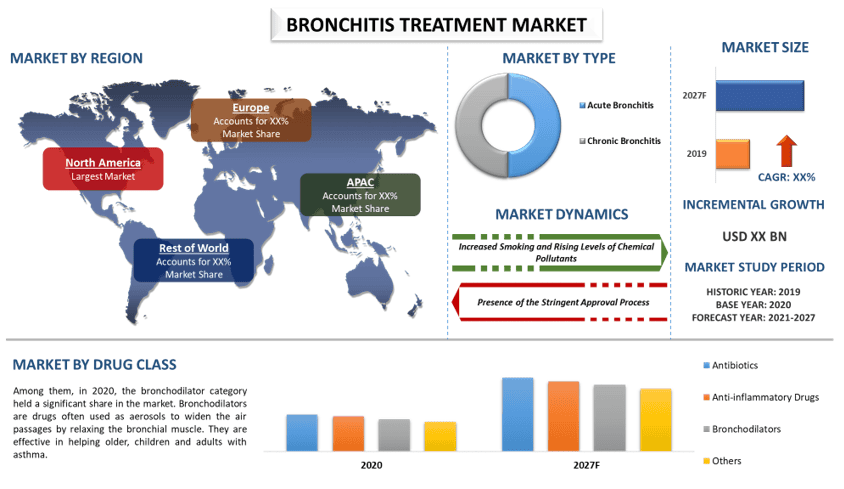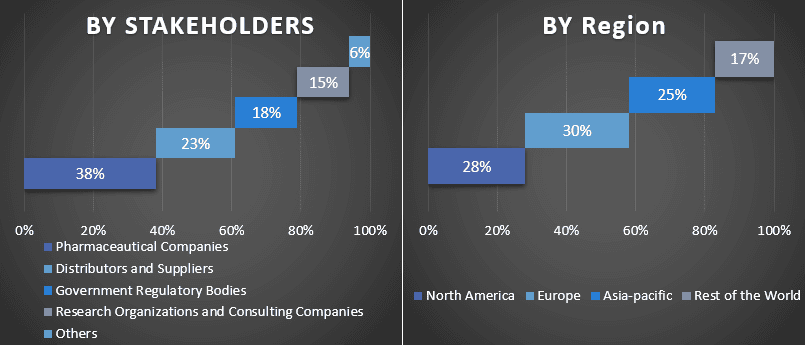- Home
- About Us
- Industry
- Services
- Reading
- Contact Us
Bronchitis Treatment Market: Current Analysis and Forecast (2021-2027)
Emphasis by Type (Acute Bronchitis, Chronic Bronchitis); by Drug class (Antibiotics, Anti-inflammatory Drugs, Bronchodilator, Other Drugs); Distribution Channel (Hospitals Pharmacies, Retail Pharmacies, Others); and Region/Country

The global bronchitis treatment market is expected to witness a CAGR of around 5% during the forecast period (2021–2027). The rising prevalence of respiratory diseases such as asthma, COPD, and lung cancer, among others coupled with rising geriatric population is expected to drive the demand for effective bronchitis treatment. According to the world health organization (WHO), around 262 million people suffer from asthma, and nearly 3 million people die from chronic obstructive pulmonary disease (COPD). Additionally, Bronchitis is when the tubes that carry air to your lungs, called the bronchial tubes, get inflamed and swollen.
AstraZeneca PLC, Novartis AG, GlaxoSmithKline PLC, Dr. Reddy’s Laboratories Ltd, Sanofi SA, Boehringer Ingelheim International GmbH, Pfizer Inc., Melinta Therapeutics, Lupin Limited, Cadila Healthcare Limited Services are some of the key players in the market. Several M&As along with partnerships have been undertaken by these players to facilitate customers with hi-tech and innovative products/technologies.
Insights Presented in the Report
“Amongst Type, Acute Bronchitis category to witness the fastest growth during the forecast period”
Based on type, the market is classified into acute bronchitis and chronic bronchitis. Amongst them, in 2020, the acute bronchitis category dominated the market and is expected to maintain its dominance throughout the forecast period. Acute bronchitis is an infectious viral infection that causes inflammation of the bronchial tubes. These tubes are the airways that carry air into your lungs. When these tubes get infected, they swell mucus (thick fluid) forms inside them. This narrows the airways, making it harder for breath-dependent patients. Furthermore, smoking is the main cause of chronic bronchitis. Therefore, an upsurge in the smoking populace is further expected to increase the need for bronchitis treatment. For instance, according to the Centers for Disease Control and Prevention (CDC), Nearly 40 million U.S. adults still smoke cigarettes, and an estimated 2.55 million middle and high school students use at least one tobacco product, including e-cigarettes.
“Amongst Drug Class, Bronchodilator category is expected to witness significant growth in the Bronchitis treatment market”
Based on drug class, the market is bifurcated into antibiotics, anti-inflammatory, bronchodilator, and others. Among them, in 2020, the bronchodilator category dominated the market and is expected to maintain its dominance throughout the forecast period. This is mainly due to the rising prevalence of chronic obstructive pulmonary disease (COPD), smoking, pollution, respiratory diseases, etc. According to the World health organization (WHO), Chronic obstructive pulmonary disease (COPD) is the third leading cause of death worldwide, causing 3.23 million deaths in 2019.
“Amongst Distribution Channel, Hospitals Pharmacies category is expected to witness significant growth in the Bronchitis treatment market”
Based on distribution channel, the market is bifurcated into hospital pharmacies, retail pharmacies, and others. In 2020, the hospitals and clinics category accounted for the majority share during the forecast period. This can be ascribed to the fact that hospitals and clinics are the first step in any disease diagnosis. In addition, the growth of this market segment includes increased incidences of respiratory diseases, growth in the geriatric population, COPD, bronchitis, asthma, smoking, and rising air pollution all over the world. Additionally, smoking is the major reason for complications of bronchitis. Furthermore, according to the office of diseases prevention and health promotion (ODPHP), Currently, more than 25 million people in the United States have asthma. Approximately 14.8 million adults have been diagnosed with COPD, and approximately 12 million people have not yet been diagnosed. Furthermore, governments across the works are investing heavily in the development and improvement of healthcare infrastructure. Moreover, rising patient footfall in hospitals owing to ease of accessibility to most healthcare services in one place is likely to boost the segment growth.
“North America to witness significant growth during the forecast period”
For a better understanding of the market adoption of the Bronchitis treatment industry, the market is analyzed based on its worldwide presence in the countries such as North America (U.S., Canada, Rest of North America); Europe (Germany, United Kingdom, France, Spain, Italy, Rest of Europe); Asia-Pacific (China, Japan, India, Rest of Asia-Pacific); and the Rest of World. In 2020. North America held an extensive market share owing to the increasing prevalence of respiratory diseases, growth in the geriatric population, COPD, bronchitis, asthma, smoking, and rising air pollution coupled with the rising geriatric population in the region. According to the US Census Bureau analysis, the elderly population is expected to nearly double in the next 25 years. In addition, according to World Population Ageing, in 2019, the elderly population of North America was 59.9 million which is expected to reach 96.2 million by 2050.
Reasons to buy this report:
- The study includes market sizing and forecasting analysis validated by authenticated key industry experts.
- The report presents a quick review of overall industry performance at one glance.
- The report covers an in-depth analysis of prominent industry peers with a primary focus on key business financials, product portfolios, expansion strategies, and recent developments.
- Detailed examination of drivers, restraints, key trends, and opportunities prevailing in the industry.
- The study comprehensively covers the market across different segments.
- Deep dive regional level analysis of the industry.
Customization Options:
The Bronchitis treatment market can further be customized as per the requirement or any other market segment. Besides this, UMI understands that you may have your own business needs, hence feel free to connect with us to get a report that completely suits your requirements.
Table of Content
Research Methodology for the Bronchitis Treatment Market Analysis (2021-2027)
Analyzing the historical market, estimation of the current market, and forecasting the future market of the bronchitis treatment market were the three major steps undertaken to create and analyze the adoption of Bronchitis treatment in major regions globally. Exhaustive secondary research was conducted to collect the historical market numbers and estimate the current market size. Secondly, to validate these insights, numerous findings and assumptions were taken into consideration. Moreover, exhaustive primary interviews were also conducted, with industry experts across the value chain of the bronchitis treatment market. Post assumption and validation of market numbers through primary interviews, we employed a top-down/bottom-up approach to forecasting the complete market size. Thereafter, market breakdown and data triangulation methods were adopted to estimate and analyze the market size of segments and sub-segments of the industry pertains to. Detailed methodology is explained below:
Seek More Details About Research Methodology
Analysis of Historical Market Size
Step 1: In-Depth Study of Secondary Sources:
Detail secondary study was conducted to obtain the historical market size of the bronchitis treatment market through company internal sources such as annual reports & financial statements, performance presentations, press releases, etc., and external sources including journals, news & articles, government publications, competitor publications, sector reports, third-party database, and other credible publications.
Step 2: Market Segmentation:
After obtaining the historical market size of the bronchitis treatment market, we conducted a detailed secondary analysis to gather historical market insights and share for different segments & sub-segments for major regions. Major segments are included in the report as type, drug class, and distribution channel. Further country-level analyses were conducted to evaluate the overall adoption of testing models in that region.
Step 3: Factor Analysis:
After acquiring the historical market size of different segments and sub-segments, we conducted a detailed factor analysis to estimate the current market size of the bronchitis treatment market. Further, we conducted factor analysis using dependent and independent variables such as various applications, equipment, and power rating of bronchitis treatment equipment. A thorough analysis was conducted for demand and supply-side scenarios considering top partnerships, mergers and acquisitions, business expansion, and product launches in the bronchitis treatment market sector across the globe.
Seek More Details About Research Methodology
Current Market Size Estimate & Forecast
Current Market Sizing: Based on actionable insights from the above 3 steps, we arrived at the current market size, key players in the Bronchitis treatment market, and market shares of the segments. All the required percentage shares split, and market breakdowns were determined using the above-mentioned secondary approach and were verified through primary interviews.
Estimation & Forecasting: For market estimation and forecast, weights were assigned to different factors including drivers & trends, restraints, and opportunities available for the stakeholders. After analyzing these factors, relevant forecasting techniques i.e., the top-down/bottom-up approach were applied to arrive at the market forecast about 2027 for different segments and sub-segments across the major markets globally. The research methodology adopted to estimate the market size encompasses:
- The industry’s market size, in terms of revenue (USD) and the adoption rate of Bronchitis treatment market across the major markets domestically
- All percentage shares, splits, and breakdowns of market segments and sub-segments
- Key players in the bronchitis treatment market in terms of products and solutions offered. Also, the growth strategies adopted by these players to compete in the fast-growing market
Market Size and Share Validation
Primary Research: In-depth interviews were conducted with the Key Opinion Leaders (KOLs) including Top Level Executives (CXO/VPs, Sales Head, Marketing Head, Operational Head, Regional Head, Country Head, etc.) across major regions. Primary research findings were then summarized, and statistical analysis was performed to prove the stated hypothesis. Inputs from primary research were consolidated with secondary findings, hence turning information into actionable insights.
Split of Primary Participants in Different Regions

Seek More Details About Research Methodology
Market Engineering
Data triangulation technique was employed to complete the overall market estimation and to arrive at precise statistical numbers of each segment and sub-segment of the Bronchitis treatment market. Data was split into several segments & sub-segments post studying various parameters and trends in the areas type, drug class, and distribution channel in the bronchitis treatment market.
The main objective of the Bronchitis treatment Market Study
The current & future market trends of the Bronchitis treatment market were pinpointed in the study. Investors can gain strategic insights to base their discretion for investments on the qualitative and quantitative analysis performed in the study. Current and future market trends determined the overall attractiveness of the market at a regional level, providing a platform for the industrial participant to exploit the untapped market to benefit as a first-mover advantage. Other quantitative goals of the studies include:
- Analyze the current and forecast market size of the bronchitis treatment market in terms of value (USD). Also, analyze the current and forecast market size of different segments and sub-segments
- Segments in the study include areas of type, drug class, and distribution channel.
- Define and analysis of the regulatory framework for the Bronchitis treatment market industry.
- Analyze the value chain involved with the presence of various intermediaries, along with analyzing customer and competitor behaviors of the industry.
- Analyze the current and forecast market size of the bronchitis treatment market for the major region.
- Major countries of regions studied in the report include Asia Pacific, Europe, North America, and Rest of the world.
- Company profiles of the Bronchitis treatment market and the growth strategies adopted by the market players to sustain in the fast-growing market
- Deep dive regional level analysis of the industry
Related Reports
Customers who bought this item also bought










